Charles E W Bean, Diaries, AWM38 3DRL 606/243B/1 - 1916 - 1926 - Part 9

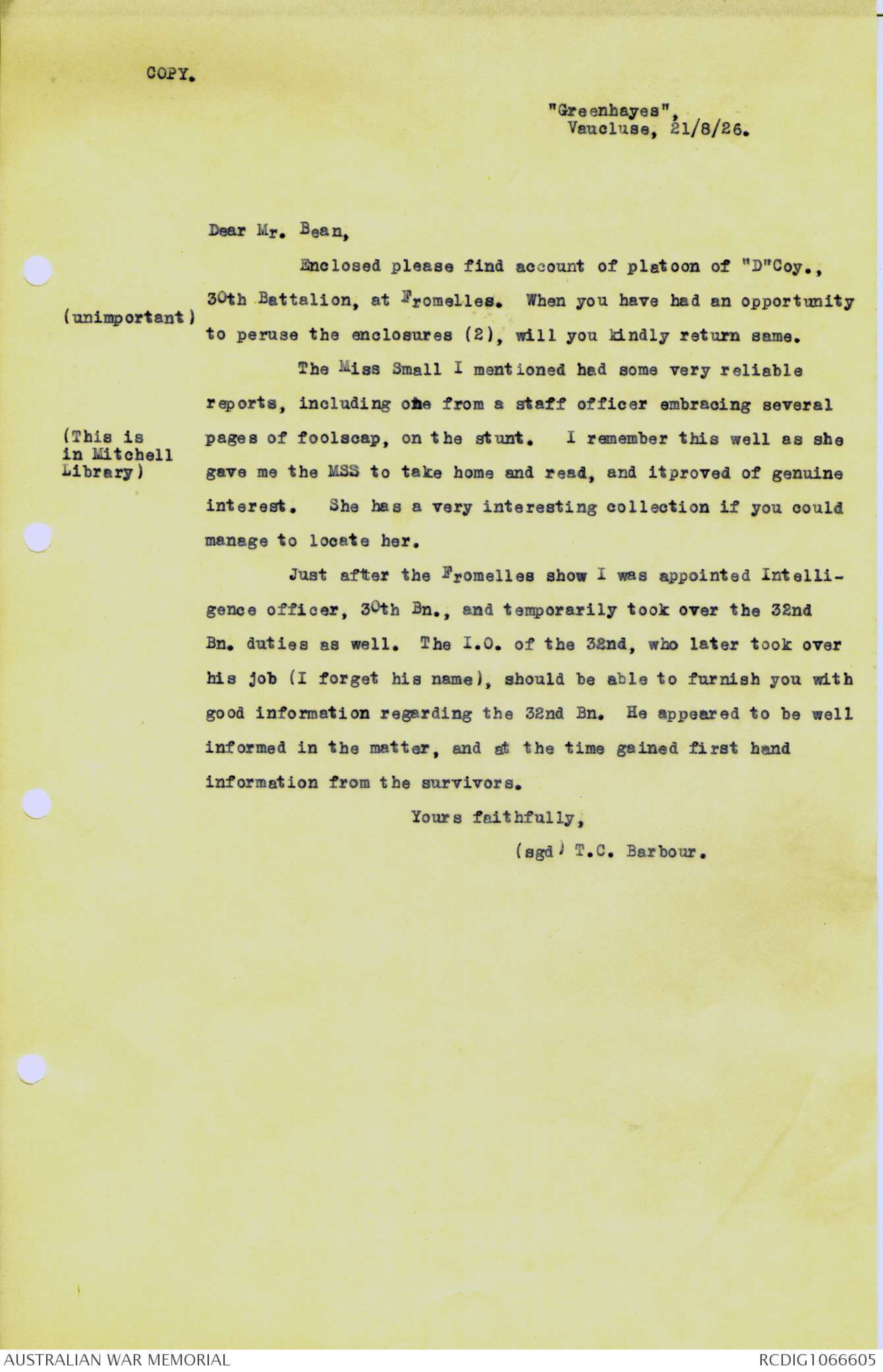

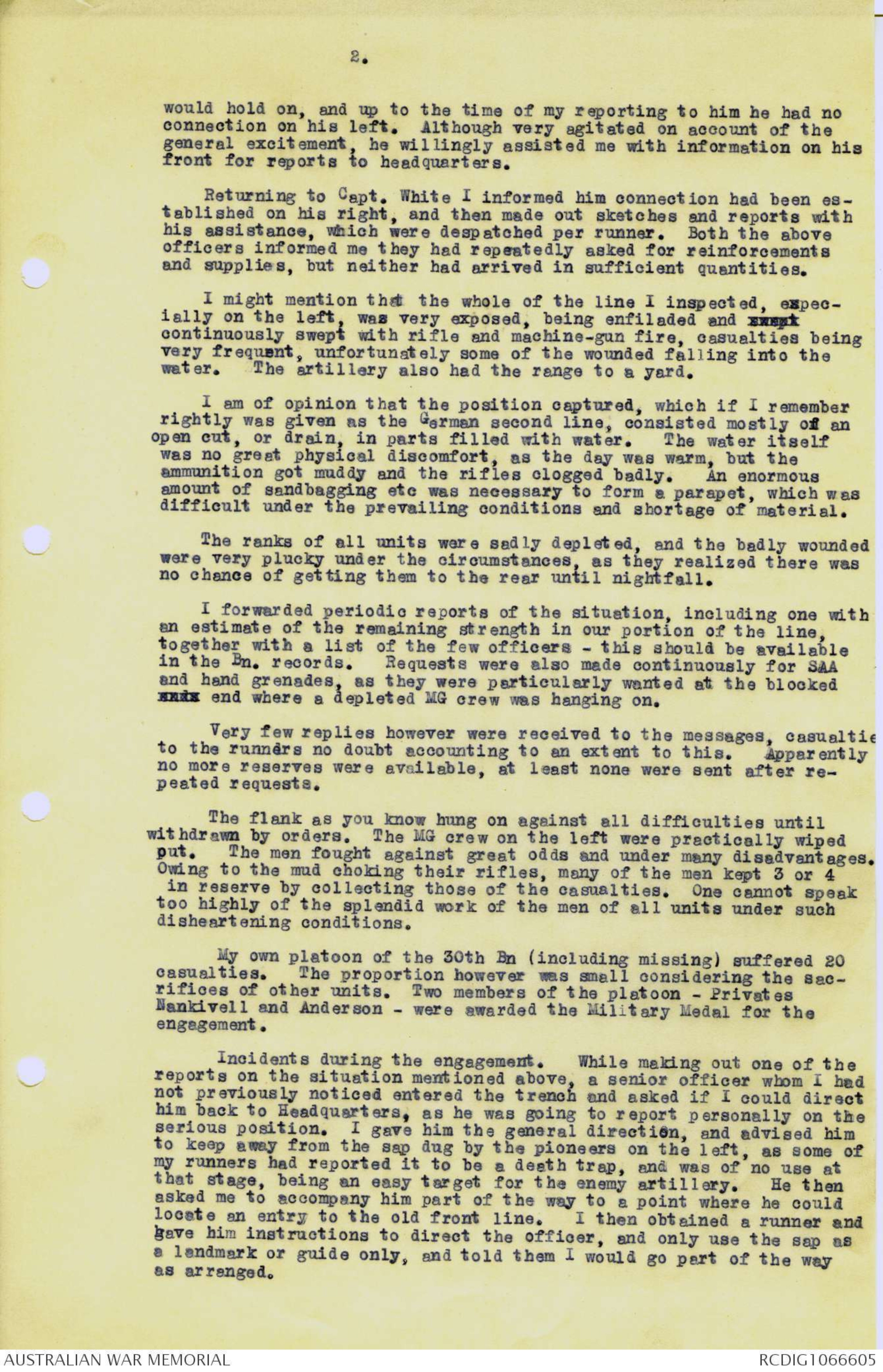
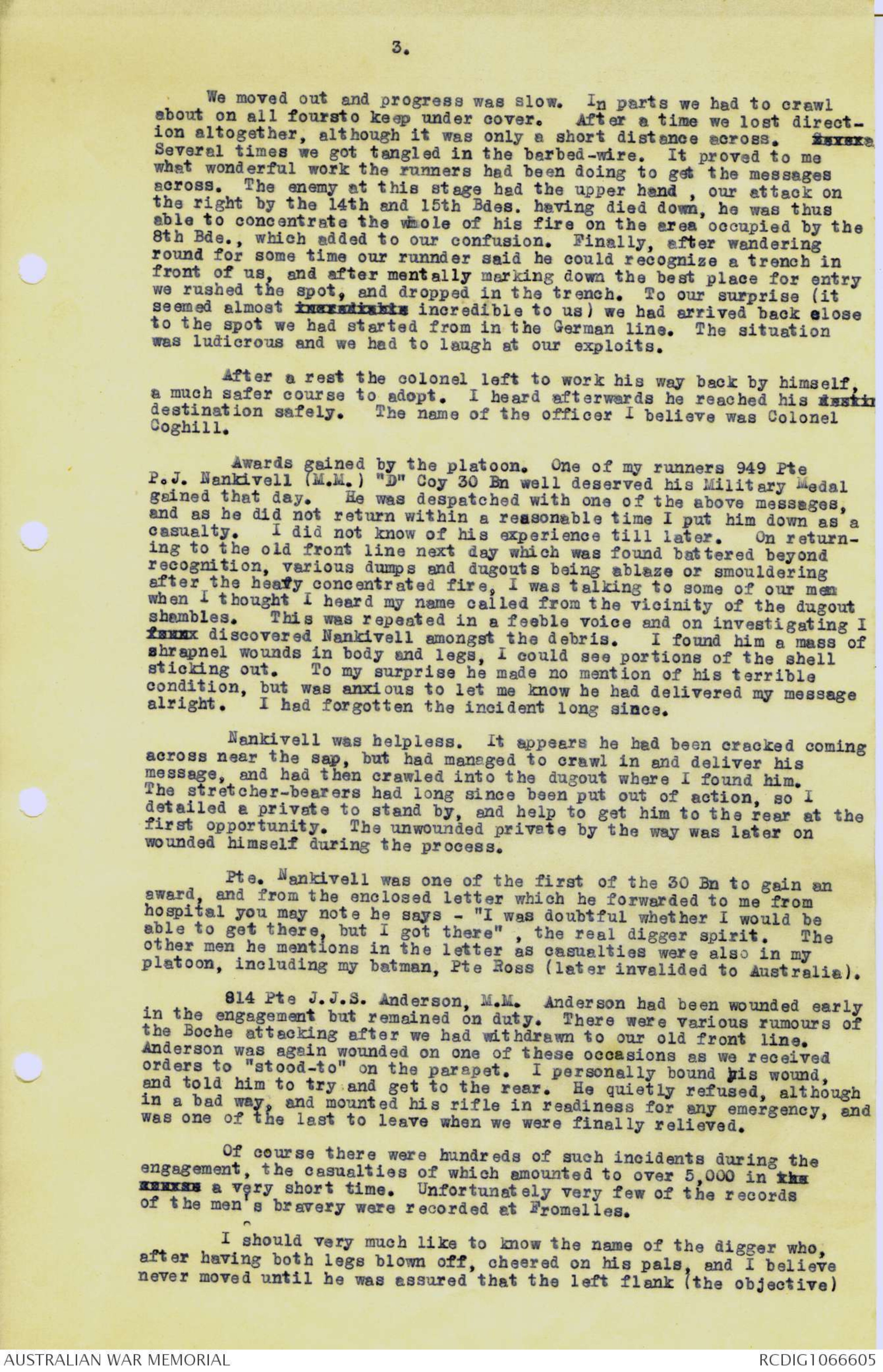
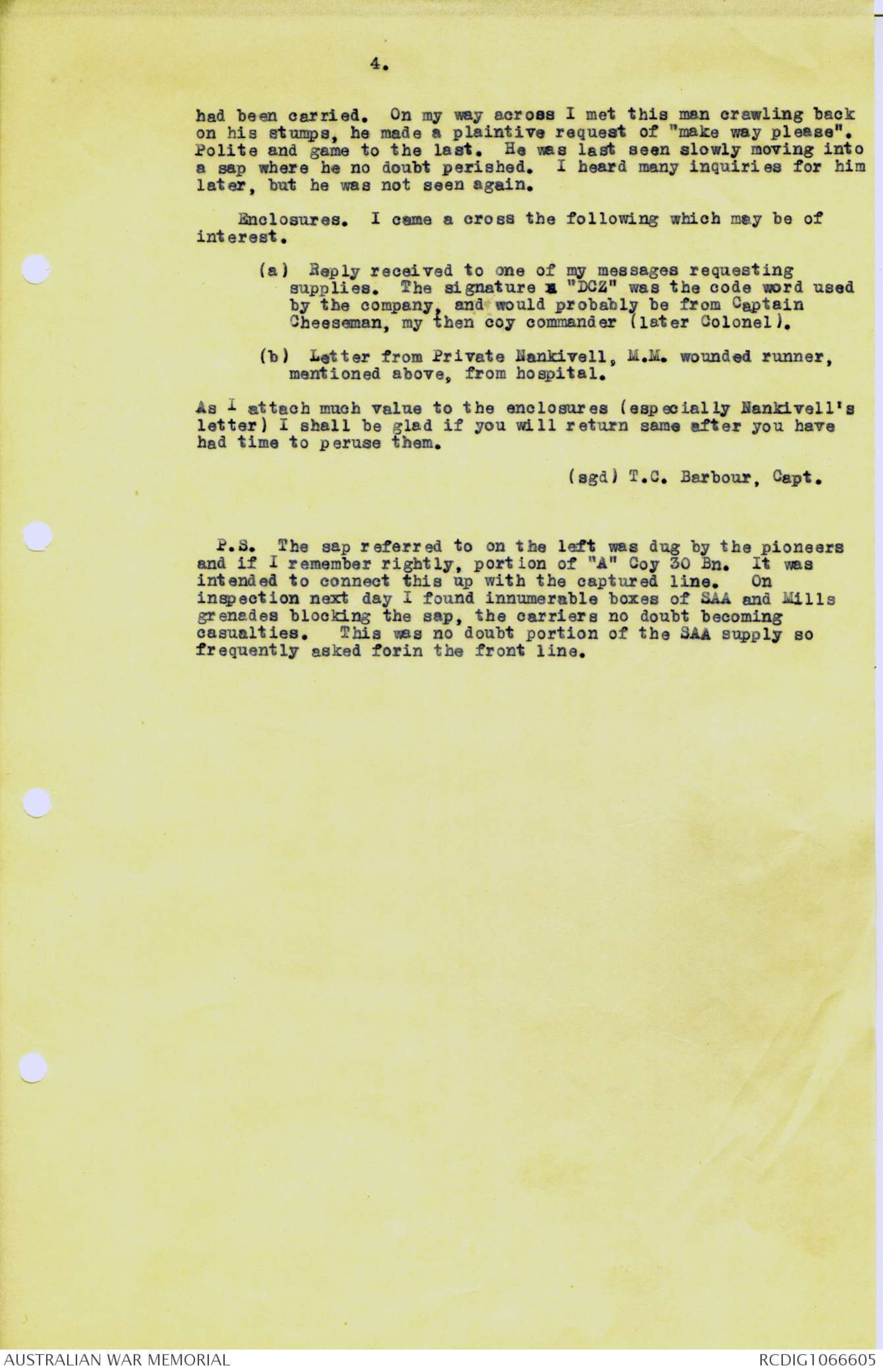
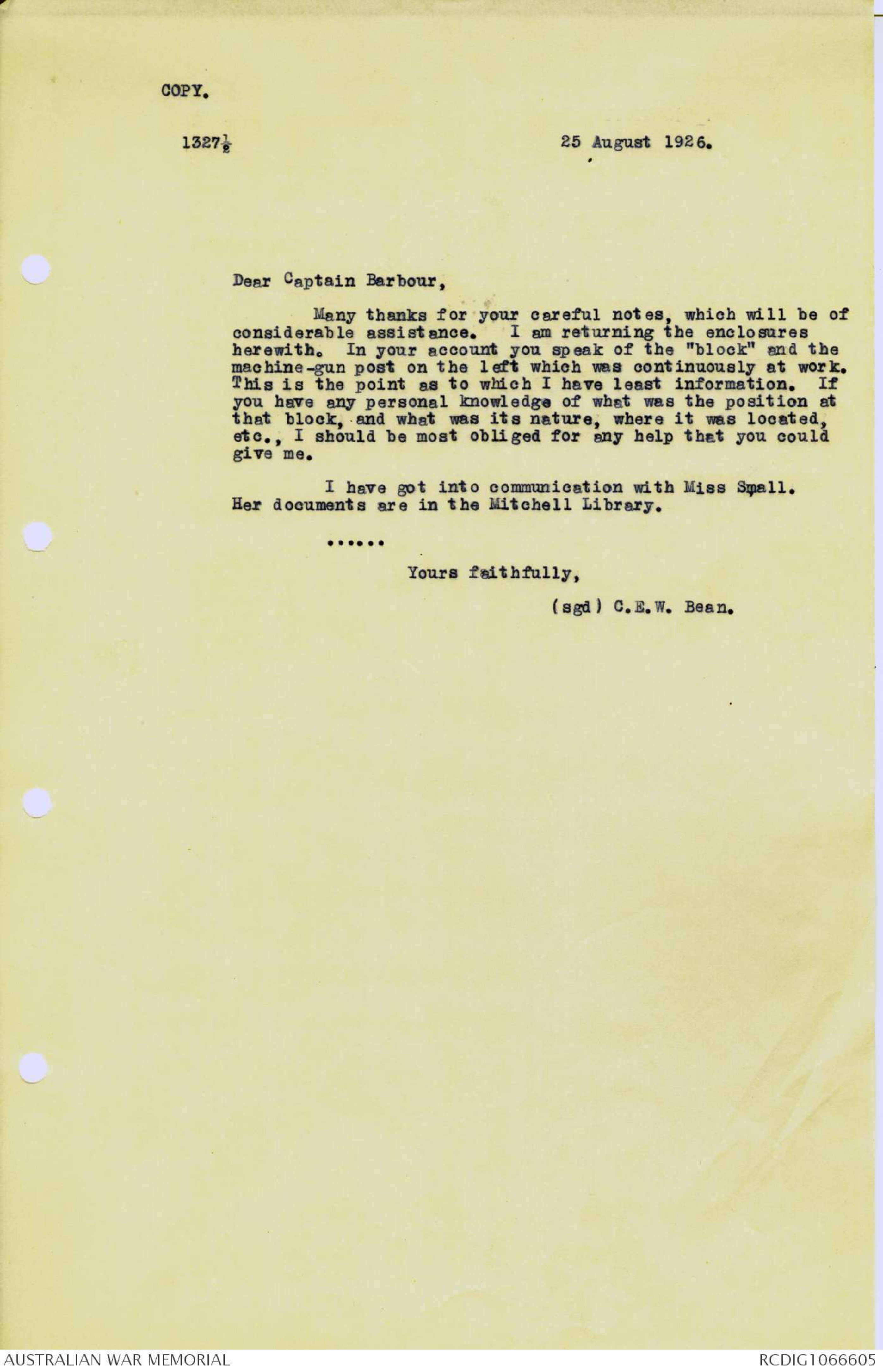
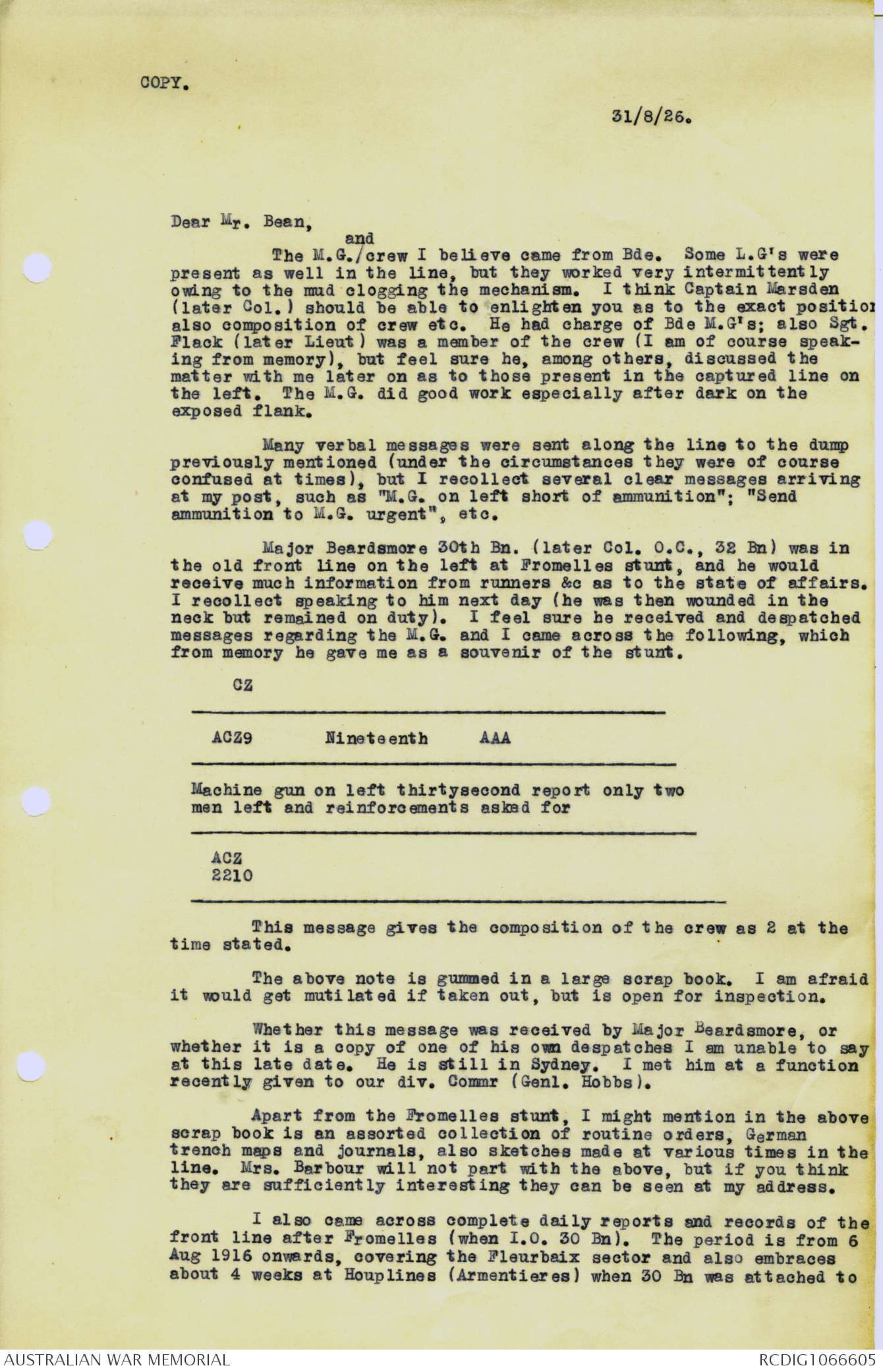
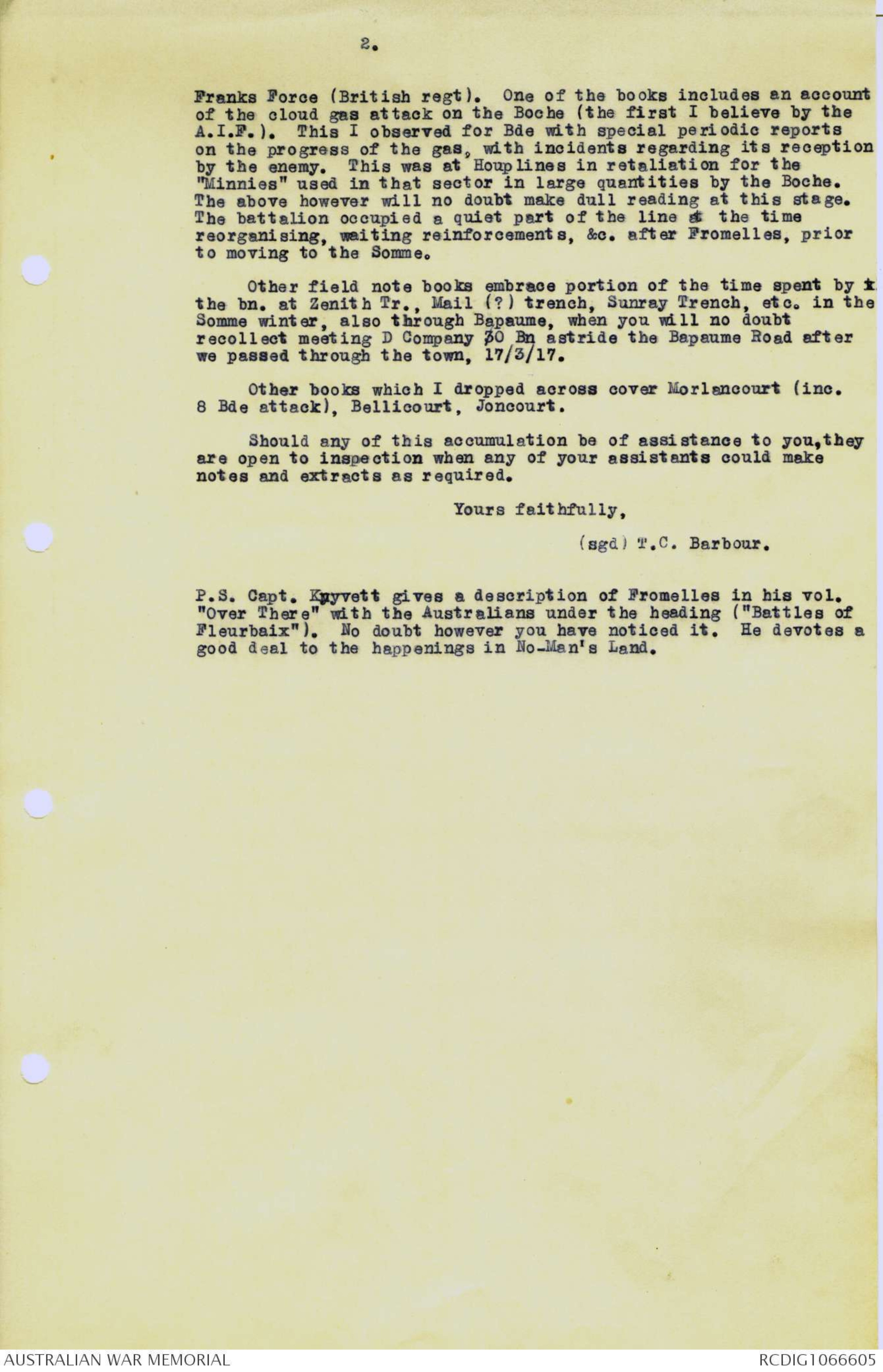
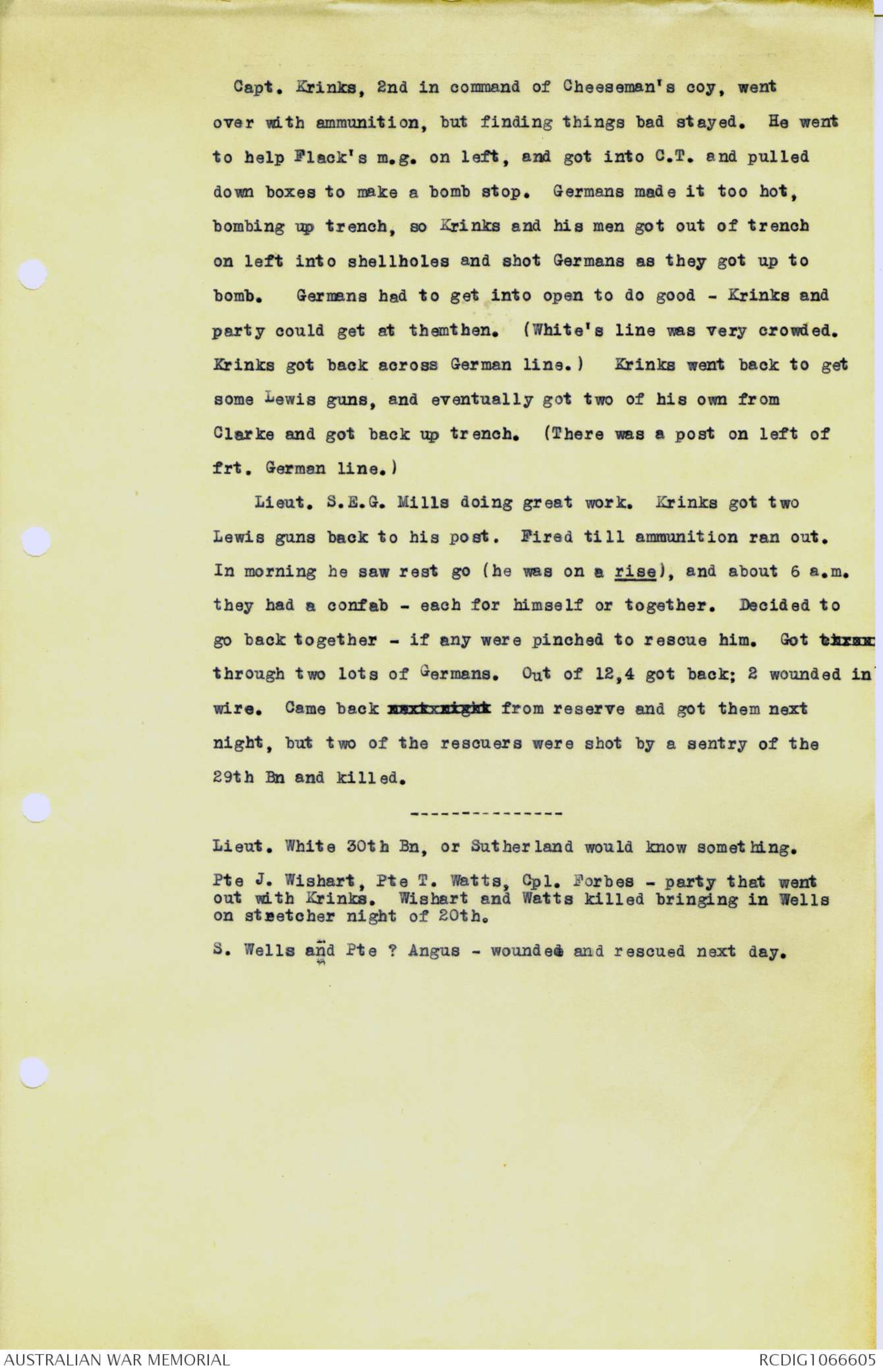
2.
D.T. by young G. Wynne. The figures quoted I think you will
find fairly correct. Lt. Charles Hamilton (of the 60th Bn., from
memory), now a solicitor in Melbourne, informed me the following
day he got out of the show with only about 20 men of his Bn. He
gave me the figures quoted which represented the first muster
with which he marched out after the event.
I might also mention on returning to Australia at the
latter end of 1919 a Miss Small, who took a great interest in the
doings of the 8th Bde and the 5th Div. generally, intended publishing
a book on the 5th Div. She forwarded me a wire which I
received on the trensport at Melbourne, asking me to contribute an
account of Fromelles. I met her later on in Sydney and left her
some MSS and photos which she may still have. Unfortunately I
did not keep a copy. I do not think the volumewas published, but
if you could get in touch with her, no doubt she would be able to
give you may interesting items, as more or less the ,atters were
fresh in one's mind at that date.
Yours faithfully,
(sgd) T.C. Barbour.
COPY.
"Greenhayes",
Vaucluse, 21/8/26.
Dear Mr. Bean,
Enclosed please find account of platoon of "D"Coy.,
30th Battalion, at Fromelles. When you have had an opportunity
[*unimportant*] to peruse the enclosures (2), will you kindly return same.
The Miss Small I mentioned had some very reliable
reports, including one from a staff officer embracing several
pages of foolscap, on the stunt. I remember this well as she
[*This is in Mitchell Library*] gave me the MSS to take home and read, and itproved of genuine
interest. She has a very interesting collection if you could
manage to locate her.
Just after the Fromelles show I was appointed Intelligence
officer, 30th Bn., and temporarily took over the 32nd
Bn. duties as well. The I.O. of the 32nd, who later took over
his job (I forget his name), should be able to furnish you with
good information regarding the 32nd Bn. He appeared to be well
informed in the matter, and at the time gained first hand
information from the survivors.
Yours faithfully,
(sgd) T.C. Barbour.
COPY.
FROMELLES.
The 32nd Bn and 31st Bn (8th Bde A.I.F.) formed the main
forces in the attack on the left in the above engagement. During
the afternoon I received urgent instructions to take over my
platoon (No. 14 "D" Coy 30th Bn) and reinforce the left flank,
which at that time was heavily engaged.
Being in support we quickly moved up to the old front line
at a point connecting with the Ox. and Bucks (English Regt).
There I met Major Purser (30 Bn) and also Captain Street (30 Bn).
Major Purser was greatly distressed at the time, informing
me his company ("C" Coy 30th) had been cut up going across on the
left where I had met him, and were unable to advance far, all the
officers being killed or wounded, among them being Captain Wark
On account of the heavy firing none of the wounded
could be reached till after dark. Major Furser personally conducted
me to a position where he thought we had a better chance
of getting over.
I immediately gave necessary instructions to my platoon
and moved over the breastworks, soon meeting with casualties with
rifle and machine gun fire. A shell also landed on the leading
section causing losses, among the casualties being Pte Ross (my
batman), who had a limb blown off. Several of us were stunned
and thrown into a shellhole. On recovering we pressed forward,
passing large bodies of our men killed and wounded. The latter
we had instructions not to assist, so as to avoid delay; and
then entered the German trench, as directed, on the left.
Water was found some 2 ft or 3 ft deep in parts, and
there was no signs of the troops we expected to meet, although
there were some wounded and dead of both sides, the German
casualties predominating. I then posted my platoon with orders
to collect as much SAA as possible (including from casualties)
and make a dump in a dry spot; also to consolidate as much as
possible. This was difficult on account of the exposed nature
of the trench.
I then worked along the sap to the left to gain information
and ultimately met an officer (Captain White, 32 Bn from memory)
to whom I reported. He was greatly relieved to hear of the
arrival of my men, as he stated he was badly in need of reinforcements.
He then explained his position to me. His men had
a bad time on the left flank, but was holding on though short of
men and ammunition. I informed him of the dump being made, and
was pleased to hear of this, and immediately made use of it,
sending up supplies, particularly to the M.G. crew at the block
end, who were continuously at work. His men were also consolidating,
sandbagging etc as much as possible.
Capt. White informed me he was unable to get any connection
on his right, and asked me to work along until I got in touch
with someone there. Apparently the 30th Bn platoon had entered a
gap in the German line.
On my returning to my men I posted them to better advantage
and worked towards the right, where firing was also going on, with
the object of establishing connection there.
After some time I came across some ^more members of the 32nd Bn.,
and later elements of the 8th Bde intermingled, occupying a
position somewhat similar to the conditions prevailing on the
left. I do not recollect meeting an officer up to this point,
the men informing me that they were mostly casualties. I therefore
kept moving to the right and finally met an officer, Capt.
Mills (from memory 31 Bn).
This officer explained xxxxx he had only a few men left but
2.
would hold on, and up to the time of my reporting to him he had no
connection on his left. Although very agitated on account of the
general excitement, he willingly assisted me with information on his
front for reports to headquarters.
Returning to Capt. White I informed him connection had been es-
tablished on his right, and then made out sketches and reports with
his assistance, which were despatched per runner. Both the above
officers informed me they had repeatedly asked for reinforcements
and supplies, but neither had arrived in sufficient quantities.
I might mention that the whole of the line I inspected, expecially on the left, was very exposed, being enfiladed and
continuously swept with rifle and machine-gun fire, casualties being
very frequent, unfortunately some of the wounded falling into the
water. The artillery also had the range to a yard.
I am of opinion that the position captured, which if I remember
rightly was given as the German second line, consisted mostly of an
open cut, or drain, in parts filled with water. The water itself
was no great physical discomfort, as the day was warm, but the
ammunition got muddy and the rifles clogged badly. An enormous
amount of sandbagging etc was necessary to form a parapet, which was
difficult under the prevailing conditions and shortage of material.
The ranks of all units were sadly depleted, and the badly wounded
were very plucky under the circumstances, as they realized there was
no chance of getting them to the rear until nightfall.
I forwarded periodic reports of the situation, including one with
an estimate of the remaining strength in our portion of the line,
together with a list of the few officers - this should be available
in the Bn. records. Requests were also made continuously for SAA
and hand grenades, as they were particularly wanted at the blockedxxxx end where a depleted MG crew was hanging on.
Very few replies however were received to the messages, casualties
to the runners no doubt accounting to an extent to this. Apparently
no more reserves were available, at least none were sent after repeated
requests.
The flank as you know hung on against all difficulties until
withdrawn by orders. The MG crew on the left were practically wiped
out. The men fought against great odds and under many disadvantages.
Owing to the mud choking their rifles, many of the men kept 3 or 4
in reserve by collecting those of the casualties. One cannot speak
too highly of the splendid work of the men of all units under such
disheartening conditions.
My own platoon of the 30th Bn (including missing) suffered 20
casualties. The proportion however was small considering the sacrifices
of other units. Two members of the platoon - Privates
Nankivell and Anderson - were awarded the Military Medal for the
engagement.
Incidents during the engagement. While making out one of the
reports on the situation mentioned above, a senior officer whom I had
not previously noticed entered the trench and asked if I could direct
him back to Headquarters, as he was going to report personally on the
serious position. I gave him the general direction, and advised him
to keep away from the sap dug by the pioneers on the left, as some of
my runners had reported it to be a death trap, and was of no use at
that stage, being an easy target for the enemy artillery. He then
asked me to accompany him part of the way to a point where he could
locate an entry to the old front line. I then obtained a runner and
gave him instructions to direct the officer, and only use the sap as
a landmark or guide only, and told them I would go part of the way
as arranged.
3.
We moved out and progress was slow. In parts we had to crawl
about on all foursto keep under cover. After a time we lost direction
altogether, although it was only a short distance across. xxxxxxx
Several times we got tangled in the barbed-wire. It proved to me
what wonderful work the runners had been doing to get the messages
across. The enemy at this stage had the upper hand, our attack on
the right by the 14th and 15th Bdes. having died down, he was thus
able to concentrate the whole of his fire on the area occupied by the
8th Bde., which added to our confusion. Finally, after wandering
round for some time our runnder said he could recognize a trench in
front of us, and after mentally marking down the best place for entry
we rushed the spot, and dropped in the trench. To our surprise (it
seemed almost xxxxxxxxxx incredible to us) we had arrived back close
to the spot we had started from in the German line. The situation
was ludicrous and we had to laugh at our exploits.
After a rest the colonel left to work his way back by himself
a much safer course to adopt. I heard afterwards he reached his xxxxxx
destination safely. The name of the officer I believe was Colonel
Coghill.
Awards gained by the platoon. One of my runners 949 Pte
P.J. Nankivell (M.M.) "D" Coy 30 Bn well deserved his Military Medal
gained that day. He was despatched with one of the above messages
and as he did not return within a reasonable time I put him down as a
casualty. I did not know of his experience till later. On returning
to the old front line next day which was found battered beyond
recognition, various dumps and dugouts being ablaze or smouldering
after the heavy concentrated fire, I was talking to some of our men
when I thought I heard my name called from the vicinity of the dugout
shambles. This was repeated in a feeble voice and on investigating Ixxxxx discovered Nankivell amongst the debris. I found him a mass of
shrapnel wounds in body and legs, I could see portions of the shell
sticking out. To my surprise he made no mention of his terrible
condition, but was anxious to let me know he had delivered my message
alright. I had forgotten the incident long since.
Nankivell was helpless. It appears he had been cracked coming
across near the sap, but had managed to crawl in and deliver his
message, and had then crawled into the dugout where I found him.
The stretcher-bearers had long since been put out of action, so I
detailed a private to stand by, and help to get him to the rear at the
first opportunity. The unwounded private by the way was later on
wounded himself during the process.
Pte. Nankivell was one of the first of the 30 Bn to gain an
award, and from the enclosed letter which he forwarded to me from
hospital you may note he says - "I was doubtful whether I would be
able to get there, but I got there", the real digger spirit. The
other men he mentions in the letter as casualties were also in my
platoon, including my batman, Pte Ross (later invalided to Australia).
814 Pte J.J.S. Anderson, M.M. Anderson had been wounded early
in the engagement but remained on duty. There were various rumours of
the Boche attacking after we had withdrawn to our old front line.
Anderson was again wounded on one of these occasions as we received
orders to "stood-to” on the parapet. I personally bound his wound
and told him to try and get to the rear. He quietly refused, although
in a bad way, and mounted his rifle in readiness for any emergency, and
was one of the last to leave when we were finally relieved.
Of course there were hundreds of such incidents during the
engagement, the casualties of which amounted to over 5,000 in thexxxxxx a very short time. Unfortunately very few of the records
of the men's bravery were recorded at Fromelles.
I should very much like to know the name of the digger who
after having both legs blown off, cheered on his pals, and I believe
never moved until he was assured that the left flank( the objective)
4.
had been carried. On my way across I met this man crawling back
on his stumps, he made a plaintive request of "make way please"
Polite and game to the last. He was last seen slowly moving into
a sap where he no doubt perished. I heard many inquiries for him
later, but he was not seen again.
Enclosures. I came a cross the following which may be of
interest.
(a) Reply received to one of my messages requesting
supplies. The signature x "DCZ" was the code word used
by the company, and would probably be from Captain
Cheeseman, my then coy commander (later Colonel).
(b) Letter from Private Nankivell, M.M. wounded runner,
mentioned above, from hospital.
As I attach much value to the enclosures (especially Nankivell's
letter) I shall be glad if you will return same after you have
had time to peruse them.
(sgd) T.C. Barbour, Capt.
P.S. The sap referred to on the left was dug by the pioneers
and if I remember rightly, portion of "A” Coy 30 Bn. It was
intended to connect this up with the captured line. On
inspection next day I found innumerable boxes of SAA and Mills
grenades blocking the sap, the carriers no doubt becoming
casualties. This was no doubt portion of the SAA supply so
frequently asked forin the front line.
COPY.
1327½ 25 August 1926.
Dear Captain Barbour,
Many thanks for your careful notes, which will be of
considerable assistance. I am returning the enclosures
herewith. In your account you speak of the "block" and the
machine-gun post on the left which was continuously at work.
This is the point as to which I have least information. If
you have any personal knowledge of what was the position at
that block, and what was its nature, where it was located
etc., I should be most obliged for any help that you could
give me.
I have got into communication with Miss Small.
Her documents are in the Mitchell Library.
......
Yours faithfully,
(sgd) C.E.W. Bean.
COPY.
31/8/26.
Dear Mr. Bean,
The M.G. ^and crew I believe came from Bde. Some L.G's were
present as well in the line, but they worked very intermittently
owing to the mud clogging the mechanism. I think Captain Marsden
(later Col.) should be able to enlighten you as to the exact position
also composition of crew etc. He had charge of Bde M.G's; also Sgt.
Flack (later Lieut) was a member of the crew (I am of course speaking
from memory), but feel sure he, among others, discussed the
matter with me later on as to those present in the captured line on
the left. The M.G. did good work especially after dark on the
exposed flank.
Many verbal messages were sent along the line to the dump
previously mentioned (under the circumstances they were of course
confused at times), but I recollect several clear messages arriving
at my post, such as "M.G. on left short of ammunition"; "Send
ammunition to M.G. urgent", etc.
Major Beardsmore 30th Bn. (later Col. O.C., 32 Bn) was in
the old front line on the left at Fromelles stunt, and he would
receive much information from runners &c as to the state of affairs.
I recollect speaking to him next day (he was then wounded in the
neck but remained on duty). I feel sure he received and despatched
messages regarding the M.G. and I came across the following, which
from memory he gave me as a souvenir of the stunt.
CZ
ACZ9 Nineteenth AAA
Machine gun on left thirtysecond report only two
men left and reinforcements asked for
ACZ
2210
This message gives the composition of the crew as 2 at the
time stated.
The above note is gummed in a large scrap book. I am afraid
it would get mutilated if taken out, but is open for inspection.
Whether this message was received by Major Beardsmore, or
whether it is a copy of one of his own despatches I am unable to say
at this late date. He is still in Sydney. I met him at a function
recently given to our div. Commr (Genl. Hobbs).
Apart from the Fromelles stunt I might mention in the above
scrap book is an assorted collection of routine orders, German
trench maps and journals, also sketches made at various times in the
line. Mrs. Barbour will not part with the above, but if you think
they are sufficiently interesting they can be seen at my address.
I also came across complete daily reports and records of the
front line after Fromelles (when I.O. 30 Bn). The period is from 6
Aug 1916 onwards, covering the Fleurbaix sector and also embraces
about 4 weeks at Houplines (Armentieres) when 30 Bn was attached to
2.
Franks Force (British regt). One of the books includes an account
of the cloud gas attack on the Boche (the first I believe by the
A.I.F.). This I observed for Bde with special periodic reports
on the progress of the gas, with incidents regarding its reception
by the enemy. This was at Houplines in retaliation for the
"Minnies" used in that sector in large quantities by the Boche.
The above however will no doubt make dull reading at this stage.
The battalion occupied a quiet part of the line at the time
reorganising, waiting reinforcements, &c. after Fromelles, prior
to moving to the Somme.
Other field note books embrace portion of the time spent by x
the bn. at Zenith Tr., Mail (?) trench, Sunray Trench, etc. in the
Somme winter, also through Bapaume, when you will no doubt
recollect mesting D Company 30 Bn astride the Bapaume Road after
we passed through the town, 17/3/17.
Other books which I dropped across cover Morlancourt (inc.
8 Bde attack), Bellicourt, Joncourt.
Should any of this accumulation be of assistance to you, they
are open to inspection when any of your assistants could make
notes and extracts as required.
Yours faithfully,
(sgd) T.C. Barbour.
P.S. Capt. Knyvett gives a description of Fromelles in his vol.
"Over There" with the Australians under the heading ("Battles of
Fleurbaix"). No doubt however you have noticed it. He devotes a
good deal to the happenings in No-Man's Land.
Capt. Krinks, 2nd in command of Cheeseman's coy, went
over with ammunition, but finding things bad stayed. He went
to help Flack's m.g. on left, and got into C.T. and pulled
down boxes to make a bomb stop. Germans made it too hot,
bombing up trench, so Krinks and his men got out of trench
on left into shellholes and shot Germans as they got up to
bomb. Germans had to get into open to do good - Krinks and
party could get at themthen. (White's line was very crowded.
Krinks got back across German line.) Krinks went back to get
some Lewis guns, and eventually got two of his own from
Clarke and got back up trench. (There was a post on left of
frt. German line.)
Lieut. S.E.G. Mills doing great work. Krinks got two
Lewis guns back to his post. Fired till ammunition ran out.
In morning he saw rest go (he was on a rise), and about 6 a.m.
they had a confab - each for himself or together. Decided to
go back together - if any were pinched to rescue him. Got threw
through two lots of Germans. Out of 12,4 got back; 2 wounded in
wire. Came back next night from reserve and got them next
night, but two of the rescuers were shot by a sentry of the
29th Bn and killed.
Lieut. White 30th Bn, or Sutherland would know something.
Pte J. Wishart, Pte T. Watts, Cpl. Forbes - party that went
out with Krinks. Wishart and Watts killed bringing in Wells
on stretcher night of 20th.
S. Wells and Pte ? Angus - wounded and rescued next day.
 Sandy Mudie
Sandy MudieThis transcription item is now locked to you for editing. To release the lock either Save your changes or Cancel.
This lock will be automatically released after 60 minutes of inactivity.